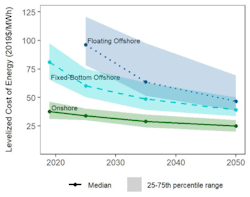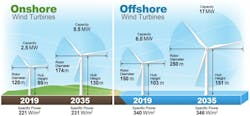Wind power companies will see levelized cost of energy drop by 17% to 35% by 2035 and 37% to 49% by 2050, driven by bigger and more efficient turbines, lower capital and operating costs, and other advancements, according to a survey of 140 wind-power industry observers taken by researchers at Lawrence Berkeley National Laboratory.
The survey also looked at levelized energy costs across three types of wind-power plants: onshore (land-based), fixed-bottom offshore and floating offshore. There are greater absolute reductions (and more uncertainty) in the levelized energy costs for offshore wind compared with onshore wind, and a narrowing gap between fixed-bottom and floating offshore wind, according to the survey. Still, predicted future costs for all three types are half what a similar 2015 survey predicted.
The federal government is trying to “maximize offshore wind potential” and identifies wind power as a key component of the nation’s efforts against climate change. Wind power could play an important role in reaching net zero carbon emissions by mid-century.
Five key factors affect the levelized cost of energy: upfront capital cost, ongoing operating costs, capacity factor, project design life and cost of financing. Experts anticipate continued improvements across all these factors.
A key driver in these improvements is turbine size, according to the survey. For onshore wind, growth is expected not only in generator ratings (to an average of 5.5 MW in 2035, up from 2.5 MW in 2019), but also in two other factors that increase capacity—rotor diameters and hub heights.
Offshore wind turbines are expected to grow to an average of 17 MW in 2035, up from 6 MW in 2019. Floating offshore wind is predicted to gain market share, going from its current pre-commercial state to account for 25% of new offshore wind projects by 2035.
The survey indicates that cost reductions have accelerated in recent years, faster than previously predicted by most forecasters and faster than historical rates of decline.
“All else being equal, these trends will let wind play a larger role in global energy supply than previously thought while facilitating energy-sector decarbonization,” says Joachim Seel, a researcher at Berkeley Lab. “Analysts, investors, planners and policymakers should avoid outdated assumptions and forecasts.” At the same time, as documented in the survey, uncertainties in the magnitude of future cost reduction are significant, illustrating the importance of including this uncertainty in modeling, as well as in policy, planning, investment and research decisions.


